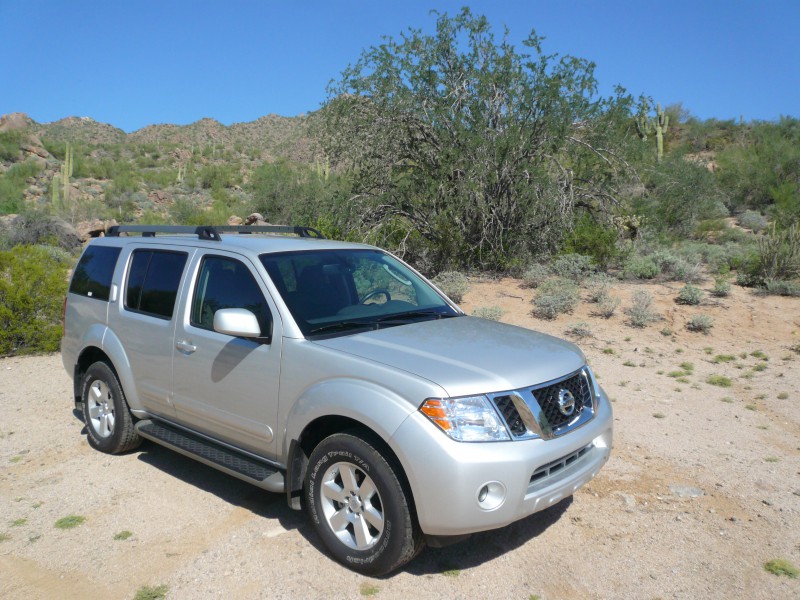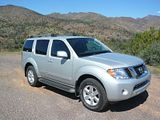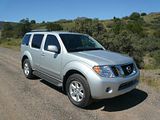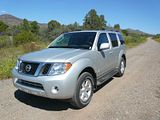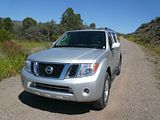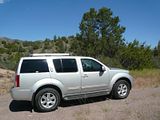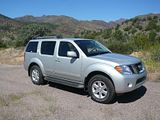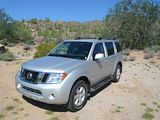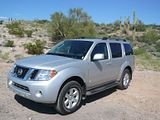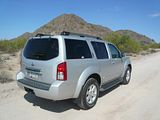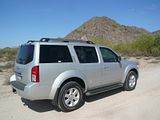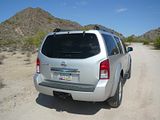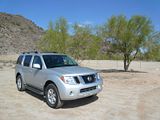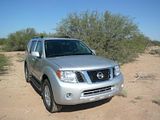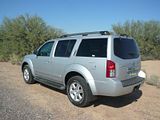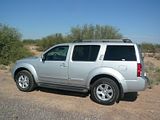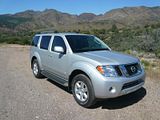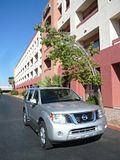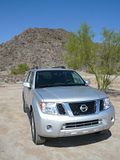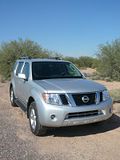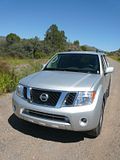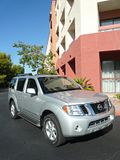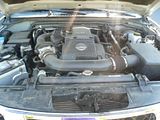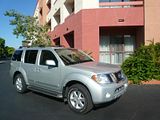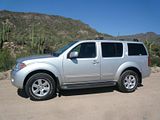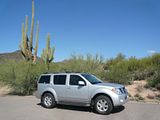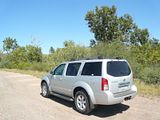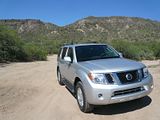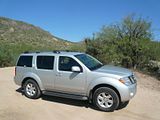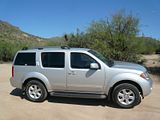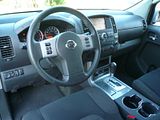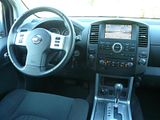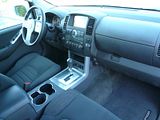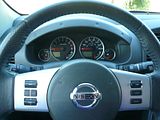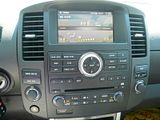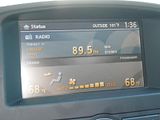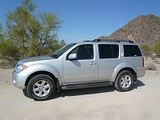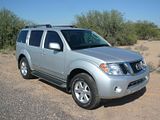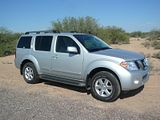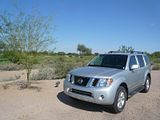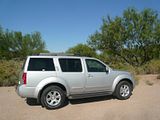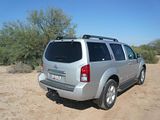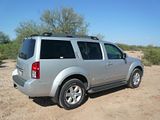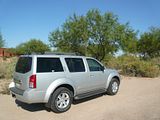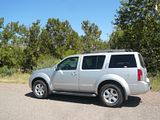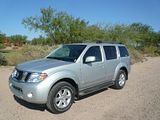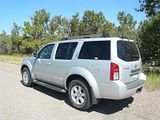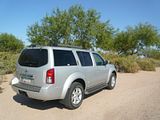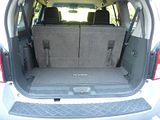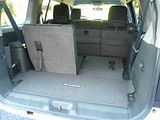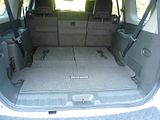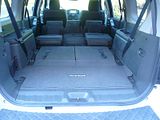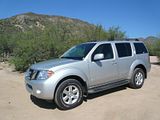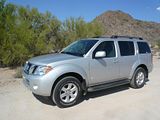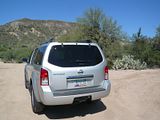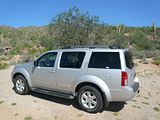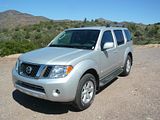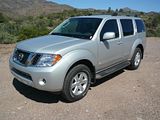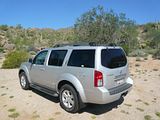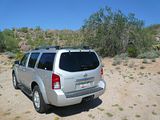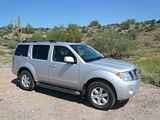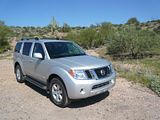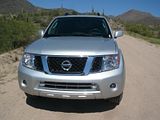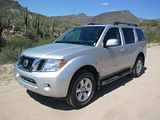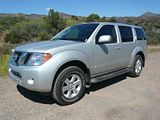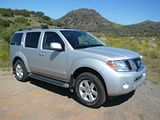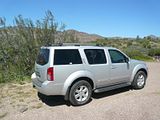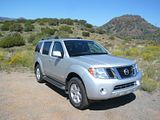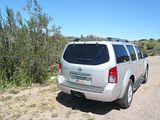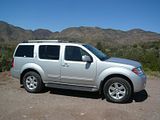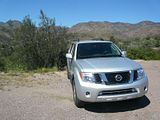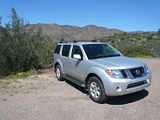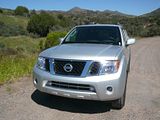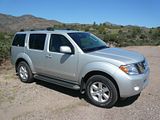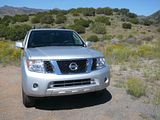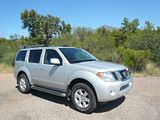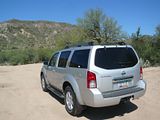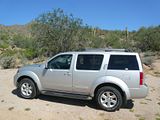
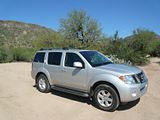
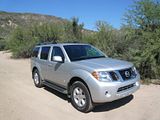


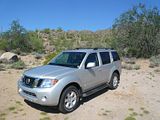
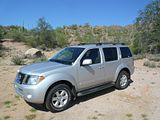
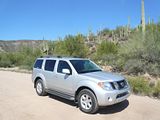

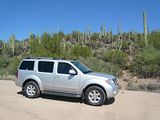
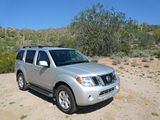
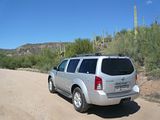


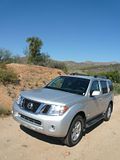
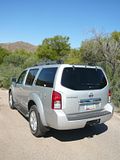
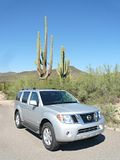

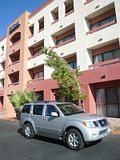
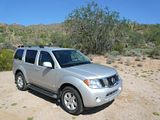
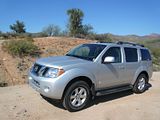
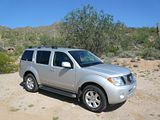
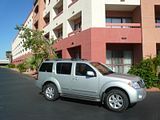
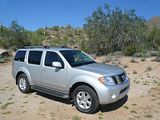
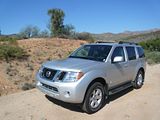
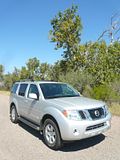
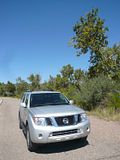
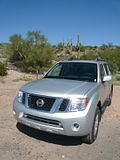
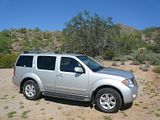
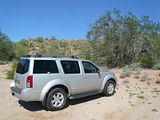
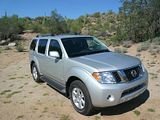
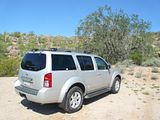




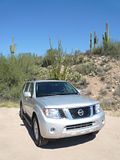
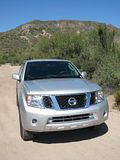
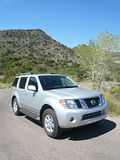
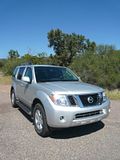
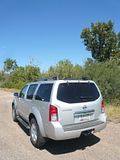

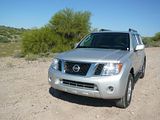
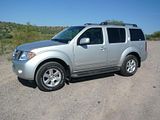
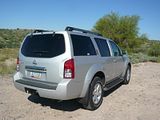

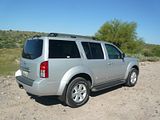
Getting into the Pathfinder, I noticed that not only is there no Start/Stop button, but you still get an old style slim key with a separate unit for the remote central locking. Put the key in the slot to the right of the column and fire the engine, and you get a sound which is not dissimilar to that you hear with a 350Z or Infiniti G35. There is a rather pleasing growl rasp to the engine at idle. Make the most of it, as that is about the only time you will hear it, though. Get underway and the engine just goes about its business. It is a 4 litre V6 unit and it develops 266bhp. It is quite a willing unit, and it revs smoothly enough, but it has the matter of making more than 5000 pounds of vehicle move, so the Pathfinder never feels better than adequately brisk. It certainly is not going to embarrass or frustrate you, and even when going up hills, it is well able to cope. How it would fare when fully laden and towing a heavy trailer I don’t know, but I would guess that this could be the time when you might find the V8 model with an extra 50 bhp and 100 lb/ft of torque is less challenged. There is a five speed automatic gearbox, which proved smooth in operation with gearchanges quite difficult to detect. There is a manual override feature if you pull the lever sidewards from Drive and then you can flick it back and forth for up and downward changes. A rotary dial on the bottom of the centre of the dash allows you to select between rear or all wheel drive and also the low ratio feature. As the test was conducted on road (apart from excursions a few feet off the tarmac for photos), I left it in rear wheel drive all the time. Tall heavy vehicles like this, especially with their truck chassis origins are never likely to be the last word in sophistication with their on road manners, but actually this Nissan was not too bad. The weighting in the steering was well judge, with plenty of feel without it ever getting unduly heavy, so the Pathfinder was easy to punt down the road. It even rode quite well, though the smooth surfaces of the roads of Arizona are a far easier test than the deteriorated surfaces in neighbouring California. The handling? Well, there is some understeer, and if you go into the bend too quickly, you would need to be wary of the high centre of gravity, so I chose not to drive with undue gusto and then all was fine. This is not a vehicle you would drive for pleasure, as it really is a workhorse, and in that respect, as long as you treat it that way, it will probably not disappoint you.
I suspected that the Pathfinder was going to struggle in the fuel economy stakes, and I was not wrong. When collected, the needle in the fuel gauge did read beyond the full mark, but it did not take too many miles before it start pointing ever lower, and by the time I got back to the hotel at the end of the first day of the test, having covered 165 miles, it was pointing at just half a tank. Knowing that the tank capacity was 21.1 gallons, that had me worried. At the end of the rental, after I filled it up and did the maths, the consumption worked out at 20.11 mpg US, or 24.0 mpg Imperial. Perhaps not quite as bad as I feared, but still far from good. After experiencing a mushy brake pedal in the SUV I had driven prior to this one, it was good to find that the brake pedal seemed to react exactly as I expected to what my right foot did, and I can report no concerns. There is a foot operated parking brake, which you press to set and press harder to release. After enjoying the sound of that V6 on start up, it is actually quite pleasing to report that overall noise levels on the move are pretty low. Wind and tyre noise is well suppressed and the engine is fairly muted until you need to work it hard. Freeway cruising is quite a relaxed matter, thanks to relatively high gearing for the fifth speed. With its boxy styling and large glass areas, visibility out is not a problem, and the Pathfinder proved easy to place on the road, and not difficult in the car parks. The mirrors are a decent size and there was no significant blind spot with which to contend. This model has a reversing camera, which projects a very clear colour image onto the display screen in the centre of the dash, which helps in spotting any low down obstacles which you might otherwise hit.
I think I would describe the interior of the Pathfinder as a mix of good and bad. The bad bit is that the materials are all very old-school hard plastics which are unpleasant to the touch and not all of them that much easier on the eye. The use of some fake carbon fibre style trim on the centre console does not really help to imbue a feeling of anything better than naff, either. There are small silver inserts on the steering wheel, around the gearlever and on the door casings, otherwise the entire interior is black, but thanks to the generous glass areas, it is not as funeral as you might fear. In fact, the basic dashboard design is good, with an elegant simplicity to what is presented. The main dials live behind a single cowl and comprise large speedo and rev counter, with smaller fuel gauge and water temperature set in the base of them, and there is an ammeter between the main dials, which is not something you see that often. They are all clearly marked and easy to read. Stalks out of the Nissan parts bin are on either side of the column, and these operate the indicators, wipers and lights. The centre of the dash has a raised unit which comes quite high up, which contains a large colour display screen which shows audio unit and climate control settings and would project satellite navigation data were that feature fitted. It is also used to project images from the rear parking camera, which were of good quality and useful when backing up. The actual controls for the audio system are a series of buttons across the width of this part of the dash below the display unit, and then there are two knobs and other buttons for the climate control system below these. There are additional climate control knobs for those in the rear seats, with a set also mounted up above the rear view mirror so the driver can set them as well as the middle row of passengers. Those rear seat passengers get their own vent outlets mounted in the roof for both middle and rearmost seats. It all proved very easy to use.
The seats in this version of the Pathfinder were trimmed in cloth, with a couple of different textures to the seat covering, the dominant one of which felt like a very soft sort of cord weave I rather liked it. On the SV version of the car, as tested, the driver’s seat has 8 way power adjustment, and there is also electrical adjustment of the pedal box, as well as manual reach and rake for the steering wheel. It was easy to get comfortable.
As with most 7 seaters, passengers in the middle row of seats do not want for space, whereas those in the rear most part of the car will be a little less comfortable. There is a lots of space for legs, shoulders and ample headroom for those middle seat passengers almost regardless of the position of the front seats in relation to the middle row. To gain access to the back row, the whole of the outer middle row seat tips forward, once you have folded the backrest down onto the cushion, but there is still quite a narrow gap between the door and the tipped forward seat so access in here is really only for the relatively agile. Once installed, there is decent space for two, and thanks to the height of the body of the Nissan, your knees do not end up near your chest. With all 7 seats erect, there is some luggage space, but not a lot. There was enough to squeeze in my suitcase and laptop bag, but only just. The last row of seats are split 50/50 and are easy to fold, simply by pulling on the lever in the rear face of the backrest, which allows that backrest to drop down onto the cushion. Folding the middle row is a little more involved, as you need to pull up each of the three seat cushions, and then use the levers on the top of the back rest for the outer ones, and a looped strap at the base of the backrest for the middle one. You will also need to adjust the seat headrests so they point up, again done by pulling a loop near the headrest base. Once the seats are all folded, there are some flaps on the backrests which can be positioned to cover the gaps and you have a long, flat floor area and an acre of space. If push came to it, you really could sleep in the Pathfinder, as the load area is that long! Places for odds and ends in the cabin included door bins, a split level glovebox, both parts of which are pretty pokey, a deep cubby under the central armrest and quite a deep recess on the bottom of the central part of the dash. There is a deep cubby to one side of the rearmost seats as well, so back seat passengers need to store things are not completely overlooked.
The test vehicle was in SV spec, which is the second of four trim levels offered. This brings quite a lot of worthwhile features over the entry level S model, including a manual override capability to the five speed automatic gearbox, dual zone climate control with separate settings for those in the rear of the car, 8 way power adjustable driver’s seat, an adjustable pedal box, an upgraded 6 CD and MP3 capable audio unit, compass, rear reversing camera, running boards and fog lights and 17″ wheels with white lettering. The Silver Edition adds leather seats, satellite radio and power adjustment for the passenger seat. Top spec LE models offer the option of the 5.6 litre V8 engine, 18″ wheels, a roof rack, a sun roof and satellite navigation. All models are available in rear or four wheel drive guises. At $34,640 for the 4WD SV model, you are getting a lot of vehicle for your money. Pathfinder prices start even lower, at just $29,290 for a 2WD S model and go up to $43,970 for the fully loaded 5.6 litre LE 4WD model.
For vehicles of its type, there was nothing seriously wrong with the Pathfinder, as long as you can afford the fuel bills. It is certainly nothing like as fun to drive as the Mazda CX9, which is probably my pick of all the SUVs of this size that I have sampled, but i you are looking for a large vehicle that can accommodate 7 with some luggage, tow up to 7000 pounds that will doubtless prove dependable for many years, then the Pathfinder could be worth a look. You’ll need to move quickly if you want a new one, as the next generation car is waiting in the wings and just like the Explorer, this one has moved from being based on a truck to a unibody based on the same platform as the front wheel Nissan Altima and Maxima. It will be interesting to see whether the market approves of this change or whether sales struggle as a consequence.

